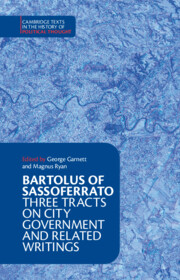Book contents
- Frontmatter
- Dedication
- Contents
- Preface
- Introduction
- Translators’ Note
- List of Abbreviations
- Glossary
- Biographies
- Further Reading
- Note on Scriptural References
- Map of Northern Italy c. 1350
- Texts
- On Guelfs and Ghibellines
- On the Government of a City
- On the Tyrant
- Appendix I: The Preface to Bartolus’s Tiberiadis
- Appendix II: Legislative Autonomy and the Universality of the Roman Empire
- Appendix III: The “City, Emperor unto Itself”
- Index of Legal Citations
- General Index
- Cambridge Texts In The History Of Political Thought
On Guelfs and Ghibellines
from Texts
Published online by Cambridge University Press: 14 November 2024
- Frontmatter
- Dedication
- Contents
- Preface
- Introduction
- Translators’ Note
- List of Abbreviations
- Glossary
- Biographies
- Further Reading
- Note on Scriptural References
- Map of Northern Italy c. 1350
- Texts
- On Guelfs and Ghibellines
- On the Government of a City
- On the Tyrant
- Appendix I: The Preface to Bartolus’s Tiberiadis
- Appendix II: Legislative Autonomy and the Universality of the Roman Empire
- Appendix III: The “City, Emperor unto Itself”
- Index of Legal Citations
- General Index
- Cambridge Texts In The History Of Political Thought
Summary
In this treatise, Bartolus of Sassoferrato explores the phenomenon of factionalism in the fourteenth-century Italian city republics. He gives an account of the local nomenclature of Guelfs and Ghibellines, relating these labels historically to the papal and imperial camps in the contested region of northern Italy. He explains that, nowadays, such labels have only local relevance, not ideological significance. He then analyses the legality of joining such parties, concluding that if the reason for doing so is to uphold the common good, it is lawful.
- Type
- Chapter
- Information
- Bartolus of SassoferratoThree Tracts on City Government and Related Writings, pp. 3 - 15Publisher: Cambridge University PressPrint publication year: 2024

